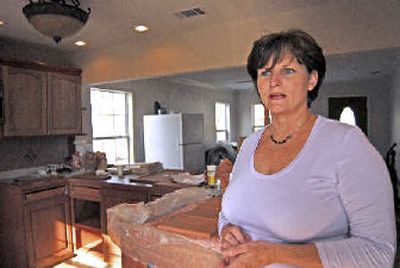Katrina victims take matters into their own hands

BILOXI, Miss. — A push to train thousands of new construction workers on the hurricane-ravaged Gulf Coast found an unlikely pupil in Sandra Ramsay, a self-employed massage therapist and hair stylist.
Like many of her neighbors, Ramsay couldn’t find a contractor to repair her storm-damaged home after Hurricane Katrina. So the 55-year-old took matters into her own hands and enrolled in a monthlong, government-sponsored crash course in construction.
Not only did she learn how to repair her Long Beach, Miss., trailer home, she’s also padding her regular income by installing drywall for other homeowners.
“I like being out there, helping people rebuild,” she said. “And I’m making money on top of it.”
With tens of thousands of homes still in ruins a year after Katrina, the construction trade here needs many more newcomers like Ramsay. A shortage of workers — compounded by an acute shortage of places to house them — is making it impossible for contractors to meet the overwhelming demand for builders, plumbers, electricians and other skilled laborers.
The shortage also has left many Katrina victims vulnerable to price gouging and scams by unscrupulous contractors.
The problems promise to grow worse in the coming months, as thousands of homeowners in Mississippi and Louisiana are set to receive hundreds of millions in government grants to pay for rebuilding.
“People realize the next struggle they’re going to face is to find a contractor,” said Andy Kopplin, executive director of the Louisiana Recovery Authority. “They may not recognize how difficult it’s going to be, but they’re cognizant of it.”
George and Janet Meaut are painfully aware of the shortage. They used to be the envy of their Biloxi neighbors, the first on the block to start rebuilding after Katrina’s flood waters hit. That was before the couple lined up contractors to handle the repairs.
Two of the contractors they hired skipped town — with their money — before finishing the job. Unable to find affordable replacements, the couple worries they’ll be the last of their neighbors to move out of a government-issued trailer and back into their home.
“All the reliable ones are taken. They’re booked up,” said George Meaut, 52. “We’re doing a lot of this ourselves because we can’t find a contractor.”
The Meauts are installing their own kitchen cabinets and tiling their bathroom and kitchen floors, but they don’t have enough money left for other jobs. They couldn’t afford a plumber, for instance, even if they could find one.
“We should have been back in our home by now,” Janet Meaut said.
The public and private sectors are teaming up to curb the labor shortage.
The U.S. Department of Labor set aside $10 million in grants for several community colleges in Mississippi and Louisiana to offer free classes in basic construction skills. The money already has paid for around 250 students, including Ramsay, to enroll in a four-week class at Mississippi Gulf Coast Community College.
The Business Roundtable, a Washington-based association of chief executives from around 160 companies, has committed $5 million to help recruit and train up to 20,000 new construction workers by the end of 2009. Louisiana’s Legislature also earmarked $15 million for the training.
Even if that initiative meets its goal, thousands more workers are needed to fill the shortage. In the New Orleans region alone, the projected demand for workers ranges from 30,000 to 100,000, according to Jim Henderson, senior vice president of work force development for the Louisiana Community and Technical College System.
Henderson said Louisiana’s “extremely low” unemployment rate — 2.9 percent in July — means the construction industry faces stiff competition for filling entry-level jobs that typically pay up to $16 an hour.
A lack of affordable housing for workers is another serious barrier, he added. “How do you solve the housing problem without a work force?” Henderson asked. “It’s a Catch-22.”
The worker shortage has been tempered by the estimated 100,000 Hispanic workers who moved to the Gulf Coast region after last year’s storm.